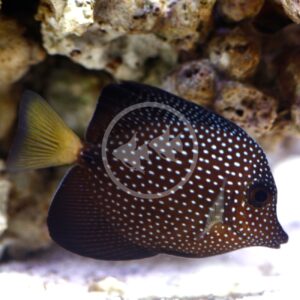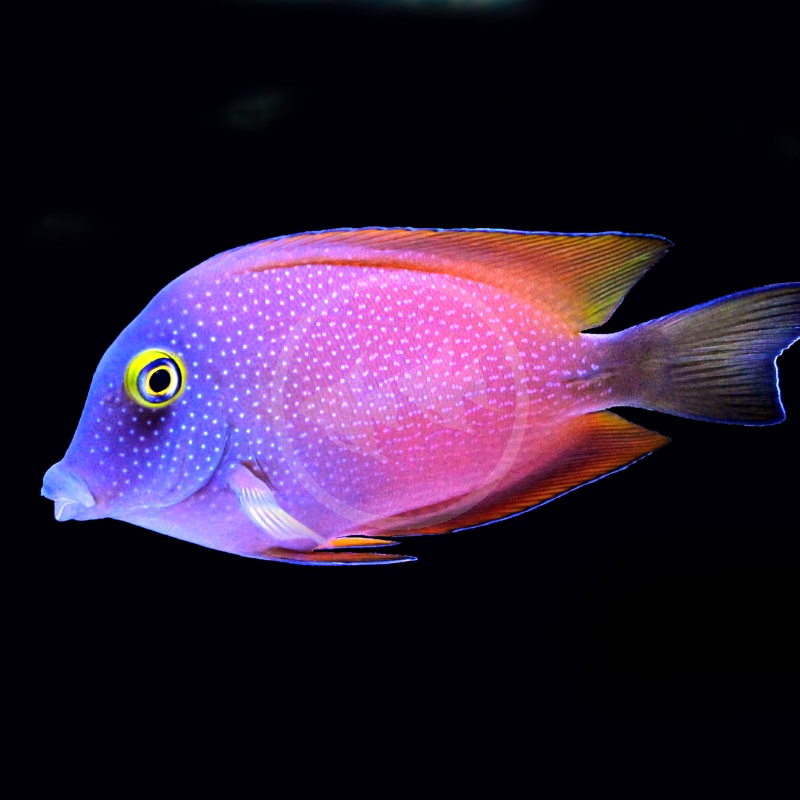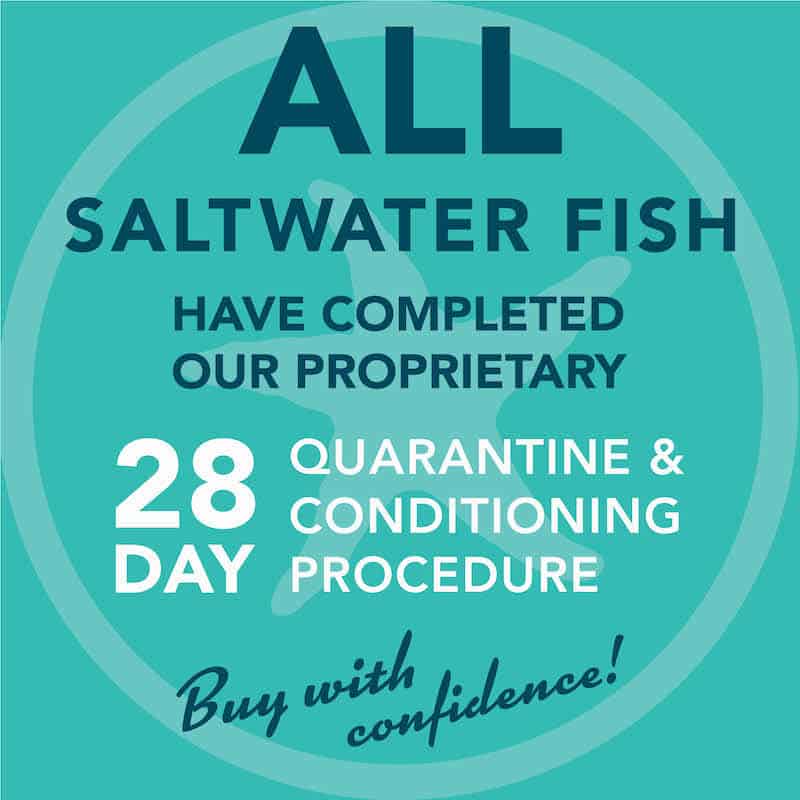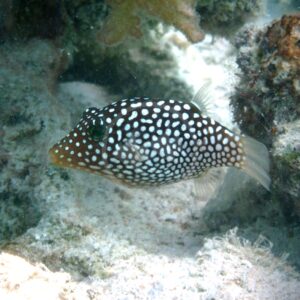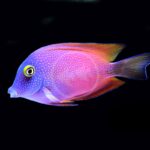

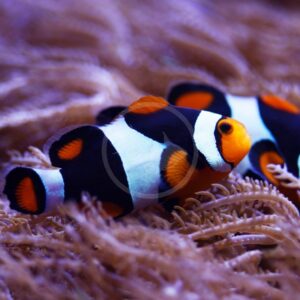
TANG – BRISTLETOOTH GOLD-RING SPOTTED Ctenochaetus truncatus
$129.99 – $169.99Price range: $129.99 through $169.99
The Gold-Ring Spotted Bristletooth Tang, also known as the Square-tail Bristletooth Tang, is native to Africa and east toward Sri Lanka in the Indian Ocean. The species name, truncatus, aptly refers to their short and box-like tail (caudal) fin that lacks the pointed tips that are characteristic of all other species in the genus Ctenochaetus. Members of Ctenochaetus are among some of the most efficient algae grazers and this species is no exception. Juvenile Gold-ring spotted bristletooth tangs have a vibrant yellow body. As an adult, the body is more of a light purple color with some yellow hues. Charmingly at any age, the Gold-ring spotted bristletooth tang is covered in an abundance of tiny white polka dots and sports a vibrant yellow eye-ring. An adult Gold-ring spotted bristletooth tang can reach a size of approximately 6″. This smaller adult size makes it quite desirable among hobbyists.
Care Level: Moderate
Temperament: Semi-Aggressive
Reef Compatible: Yes
General Description: The Gold-Ring Spotted Bristletooth Tang, also known as the Square-tail Bristletooth Tang, is native to Africa and east toward Sri Lanka in the Indian Ocean. The species name, truncatus, aptly refers to their short and box-like tail (caudal) fin that lacks the pointed tips that are characteristic of all other species in the genus Ctenochaetus. Members of Ctenochaetus are among some of the most efficient algae grazers and this species is no exception. Juvenile Gold-ring spotted bristletooth tangs have a vibrant yellow body. As an adult, the body is more of a light purple color with some yellow hues. Charmingly at any age, the Gold-ring spotted bristletooth tang is covered in an abundance of tiny white polka dots and sports a vibrant yellow eye-ring. An adult Gold-ring spotted bristletooth tang can reach a size of approximately 6″. This smaller adult size makes it quite desirable among hobbyists.
Diet Requirements: In the wild tangs are primarily herbivorous. A diet largely consisting of algae-based foods is absolutely necessary to maintain optimal health, coloration, immune function, and reduce aggression. Vegetable based flake foods or frozen foods, that may also include spirulina algae, are excellent options. We also recommend offering dried seaweed on a rock or clip three times a week minimum. Bristletooth tangs will consume various other protein-based frozen foods.
Care Requirements: A minimum 90 gallon aquarium is ideal. Smaller specimens can be temporarily raised in smaller quarters as long as it is upgraded accordingly. This tang enjoys a variety of rock work to graze off of and crevices to take refuge, but should also be provided with some open swimming space. Typically, Ctenochaetus species are only semi-aggressive and territorial in nature toward members of its own genus, often behaving peacefully toward other tank-mates. However, if you want to house various types of tangs together, it is best to add them all at once, or closely together at the very least, for the best success. Recommended water conditions, 72-78° F, KH 8-12, pH 8.1-8.4, salinity 1.020-1.025.
Purchase Size: Small: 1-1/2″ to 2-1/2″ Medium 2-1/2″ to 4″
Note: Your item may not look identical to the image provided due to variation within species. Purchase sizes are approximate.
Dry goods orders are shipped via US Postal Service or UPS to the address provided at checkout based on the selection made in your website shopping cart. Product is carefully packed to help prevent any damage during shipping. Once processed you will receive a shipment notification via email with tracking number, and delivery notification. Please allow 48 hours for processing after your order is placed.
Perishable items (i.e. live plants, refrigerated/frozen foods) are shipped via US Postal Service 2-3 day to the address provided at checkout for a $25.00 flat rate charge. Items are packed with secure packing material and heat, cold, or Cryo packs as needed to maintain safe temperatures during transit. If one or more perishable items are in the shopping cart at checkout the $25.00 perishable shipping charge will automatically appear and need to be selected. Once processed you will receive a shipment notification via email with tracking number. Please allow 48 hours for processing after your order is placed.
Livestock (i.e. fish, invertebrates, coral) are shipped via UPS Overnight to the address provided at checkout for a $55.00 flat rate charge. Livestock is packed in insulated styrofoam boxes with secure packing material and heat, cold, or Cryo packs as needed to maintain safe temperatures during transit. If one or more livestock items are in the shopping cart at checkout the $55.00 livestock shipping charge will automatically appear and need to be selected. Livestock is shipped Monday through Wednesday ONLY (no weekend delivery is available) weather permitting, and we reserve the right to delay shipping until conditions are appropriate for safe arrival. Once your order is placed we will contact you to arrange the best shipping date based on these criteria. Someone must be available to receive the livestock order on the first delivery attempt. Once processed you will receive a shipment notification via email with tracking number. Please allow 48 hours for processing after your order is placed.
For mixed dry goods/perishable & livestock orders items will be shipped via their corresponding shipping methods outlined above. Dry goods will be shipped via US Postal Service or UPS based on your selection and checkout, while livestock will ship via UPS Overnight for a $55.00 flat rate charge. You will receive separate notifications and tracking numbers for the dry goods and livestock. Please note due to different carriers and shipping methods dry goods and livestock may arrive on different days.
Related products
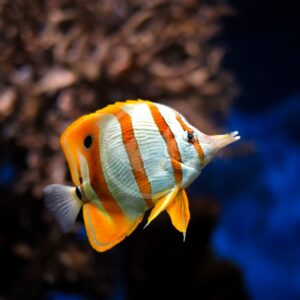

BUTTERFLY – COPPERBAND Chelmon rostratus
$109.99 – $219.99Price range: $109.99 through $219.99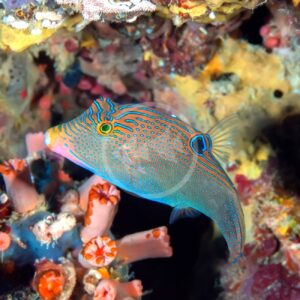

PUFFER – BLUE SPOT Canthigaster solandri
$89.99 – $149.99Price range: $89.99 through $149.99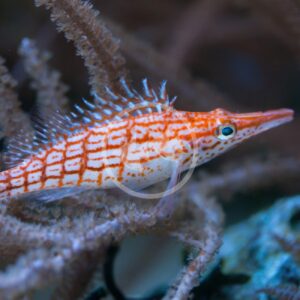

HAWK – LONGNOSE Oxycirrhites typus
$129.99 – $159.99Price range: $129.99 through $159.99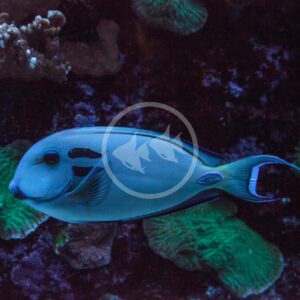

TANG – LIEUTENANT Acanthurus tennenti
$139.99 – $209.99Price range: $139.99 through $209.99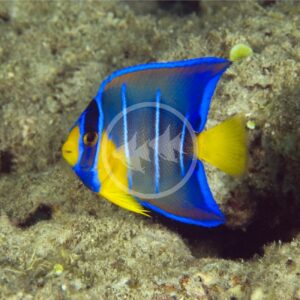

ANGEL – BLUE Holacanthus bermudensis
$349.99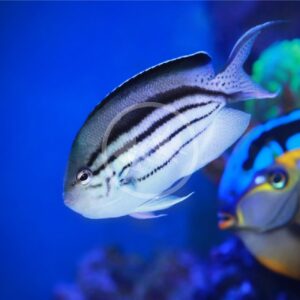

ANGEL – LAMARCK Genicanthus lamarck
$99.99 – $299.99Price range: $99.99 through $299.99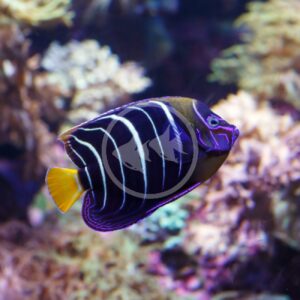

ANGEL – CHRYSURUS Pomacanthus chrysurus
$269.99